Hyoscyamus, HenbaneJusquianaKhurasani Ajwain (Ayurveda) Kurocani Oman (Siddha) Tian Xian Zi 天仙子 (TCM, Seed) Lang Dang (TCM) Lang thang rtse ལང་ཐང་རྩེ་ (Tibet, Seed) |

|

|
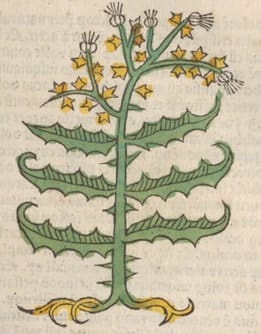 Hyoscyamus
HyoscyamusHerbarius latinus, Petri, 1485 |
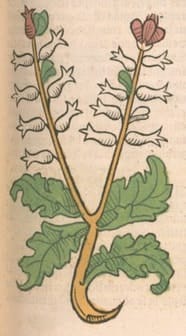 Hyoscyamus
HyoscyamusOrtus Sanitatis, Meydenbach, 1491 |
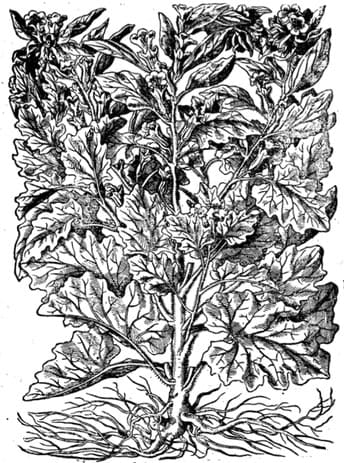 White Henbane
White HenbaneNew Kreuterbuch, Matthiolus, 1563
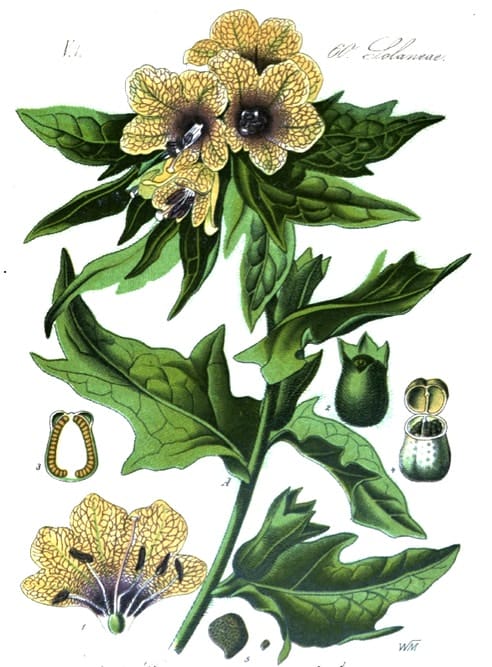 Hyoscyamus niger
Hyoscyamus nigerFlora von Deutschland (16), Kohler, 1884 |
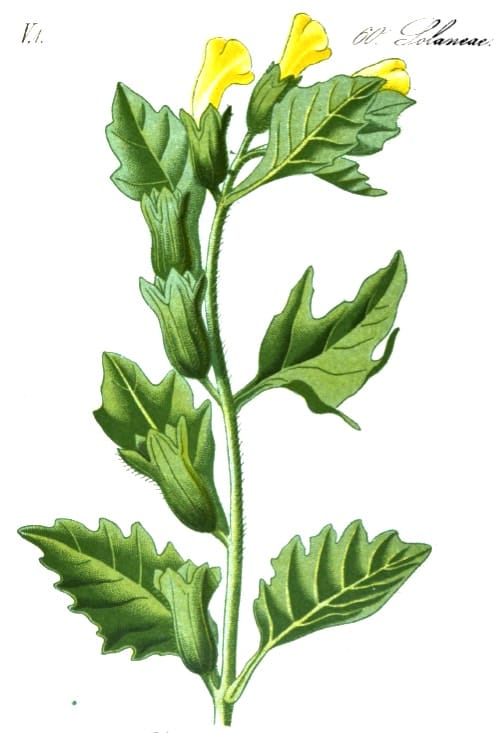 Hyoscyamus alba
Hyoscyamus albaFlora von Deutschland (16), Kohler, 1884 |
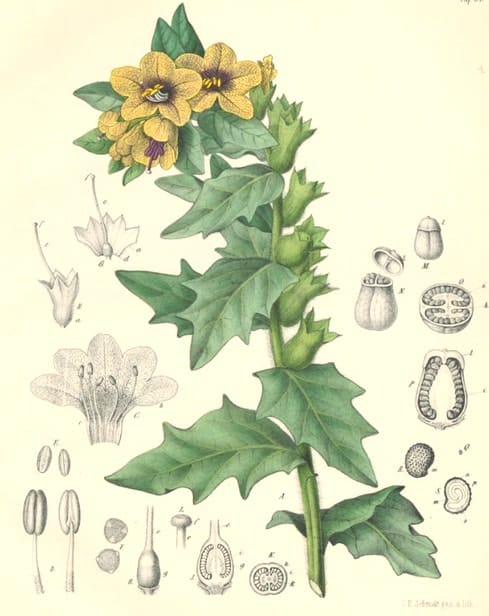 Hyoscyamus niger
Hyoscyamus nigerAtlas der Officinellen Pflanzen, Berg & Schmidt, Leipzig, 1893
Botanical name:
Hyoscyamus alba
Based on their flower color, several types wre known:
- White (white or yellowish-white flowers): H. alba–best and most used
- Black (dark purple flowers): H. nigra–not used
- Purple (purple flowers); probably a variety of H. nigra–not used
- Red (yellow flowers)–not generally used
the Red variety may be used only if the White is not available but the black variety should always be avoided”..
Parts used:
Root, Seed and Leaves; mostly the seed in the Western tradition.
Galen said the juice was extracted and dried, and used as Opium in his time.
Temperature & Taste:
‘Cold in the 3rd degree, dry in the 1st’. Bitter, pungent, Toxic
Considered Warm by some in TCM, however, others agreed it is cold. ‘According to Shen Nong Ben Cao Jing., the drug is cold in quality. But later Bencao works all recorded that the drug is very hot ‘ (Su Song)
Classifications:
2L. EMOLLIENT. 2N. REPELLENT. 2O. ASTRINGENT. 2P. HEMOSTATIC. 2R. NARCOTICS & HYPNOTICS
3M. ARTHRITIC
4k. ARTHRITIC
TCM:
T. External Medicines
Uses:
HERB:
1. Calms Spasms, Relieves Pain:
-Urinary Pain from irritable bladder
-Abdominal Pain (seed is used for this function in TCM)
-Henbane was applied as a sedative and analgesic for right-sided migraine in the Ebers Papyrus.
-pain associated with muscular tension or spasm
-used as a substitute for Opium
2. Calms the Mind, Stops Spasms, Promotes Sleep, Eases Pain:
-‘To wash the feet in a decoction of Henbane… causes sleep’ (Gerard)
-’Provokes sleep, stupifies … disturbs the Reason’. (Schroder)
-insomnia, fright, and terror during sleep.
-Severe Nervous Irritability, acute Mania, Paralysis Agitans, Delerium Tremens
-Senile Tremors, Parksinson’s (Leclerc)
-Delirium when the person is busy, talkative or singing; Delirium with Hallucinations
-Epilepsy, Convulsions, Insanity and Nymphomania
3. Stops Cough and Asthma:
-Asthmatic Cough, chronic Coughs, Asthma, Whooping Cough, dry or spasmodic coughs
-Seed is used for this purpose in TCM
4. Used for incipient Diabetes
5. Resists Poison:
-Mercury poisoning
6. Externally:
-pains in the joints: gout, sciatica, chronic rheumatism, arthralgia and arthritis
-pain of the eyes (laid on eyelids and temples)
-Neuralgia
-Sores, Swellings, Boils, Ulcers, Scrofulous Ulcers
-topically for Scrofula, Tumors, and Cancers
-externally for cramps or pain of the bowels, bladder, abdomen
-decoction is also a good wash externally for Lice
-’Mollifies wonderfully’. (Schroder)
SEED:
1. Astringes, Stops Leakage and Bleeding:
-“a strange and admirable virtue” for Incontinence and Diabetes (Salmon)
-Chronic Diarrhea, Chronic Dysentery, prolapse of the Rectum
-Seeds are used to stop bleeding; spitting of Blood, Blood in the Urine.
2. Calms the Mind, Stops Spasms, Eases Pain:
-used similarly to the herb;
-Epilepsy, Convulsions
-Insanity, Mania, Manic-depressive Psychosis. (West, TCM)
-“numbness and arthralgia of the muscle with contraction and spasm’ (Shen Nong Ben Cao)
-“long term use makes one feel happy and vigorous” … “reinforces Willpower”. (Shen Nong Ben Cao)
-“The dmg can be used in a prescription designed to treat manic-depressive Psychosis”. (Tao Hong Jing)
-Gastric spasm and pain
3. Stops Cough and Wheezing, Clears Phlegm:
-Spasmodic Cough, Asthma
–Gerard said the seed of White Henbane is good for cough with watery Sputum
4. Benefits Eyesight:
-benefits hearing and eyesight (Chen Cang Qi)
-“turns white hair black”. (Chen Cang Qi)
5. Externally:
-in TCM the seed is applied to all painful swellings, as well as Hemorrhoids and Rectal Prolapse.
-Oil of the seed is dropped into the ear for Deafness and pains of them
–Toothache, take the fume of the seed into the mouth
Dose:
1. Herb and seed can be used in similar doses.
2. Always begin with lesser doses, increasing as needed.
Powder: 60–600mg. A pinch of the powder was often used as a dose. Avicenna recommended 750mg with Hydromel for Gout pain, and 1500mg in Hemoptysis.
Dry Herb Tincture (1:10 in 60% alcohol): 1–10 drops, or according to the British Herbal Compendium, 2–5 mls.
Preparation:
1. Washed Henbane Seed:
The seed can be washed in water and dried, repeating several times. This reduces toxicity.
2. Vinegar prepared Henbane Seed:
The Seeds are corrected by being steeped in Vinegar, then dried for use. This lessens toxicity. (Unani, TCM)
Another version stews the seed in vinegar, then wash and soak in cow milk overnight. Wash again, then dry in the sun.
3. Urine Prepared Henbane Seed:
Soak in Urine until it is absorbed, then dry in the sun. This reduces toxicity.
4. Stir-fried Henbane Seed:
The seed may be dry-fried until lightly scorched. This reduces toxicity. It is used for prolapse of the anus and dysentery from Cold. (Ben Cao Gang Mu)
5. Lime-prepared Henbane Seed:
Stew the seed with Lime in water for a day. Then remove and dry in the sun. (Zhen Quan)
Corrective:
1. Honey; Hydromel (Honey Water) (Unani)
2. Licorice
Substitutes:
1. Poppy seed has been used as a substituted.
2. Henbane was used as a substitute for Opium as it does not cause constipation.
3. Belladonna and Henbane are very similar in effect; they may generally substitute one another.
Comment:
1. The herb is ‘Seldom used inwardly’, although the Seed appears in a number of classical formula.
2. “After one takes the seed, one will get wild and behave maniacally. So it is named Lang Dang (wild and manic behavior)”. (Li Shi Zhen)
Main Combinations:
For pain, to promote calm an rest, for Bleeding, Cough and Asthma, Henbane seed is often combined with Poppy seed.
Pain, Spasms:
1. Antispasmodic, Henbane with Valerian
2. Nervous diseases Henbane with Datura and Hops
3. Hysteria, Henbane with Asafetida, Cannabis and Camphor (Ayurveda)
4. Parkinson’s Disease, Henbane seed with Mucuna, Withania and Sida cordifolia (Ayurveda)
5. To ease pain:
i. Henbane seed with Saffron, Pyrethrum, Indian Spikenard, White Pepper and Opium (as in Confect Easing Pain of Galen)
6. Sedative Pills: Extracts of Henbane, Opium, Belladonna, Hemlock (equal parts). Make pills of 1 grain each. Increase the dose until 6 pills are taken each night (especially used for tic doloreux)
Bleeding & Leakages:
7. Leakages and Bleeding including excess Menstruation, Diarrhea, Catarrh, Leukorrhea etc., Henbane seed with White Pepper, Opium, Lemnian Earth, Saffron, Pearl, Hematite, Zedoary, Elecampane and Camphor (as in the classical Philonium)
8. For Bleeding, Henbane seed is combined with Poppy seed and Conserve of Roses
9. Cold abdominal pain and Dysentery, Lime-prepared Henbane seed, Aconitum Fu Zi, Cinnamon (Gui Xin), Ginger, Citrus Chen Pi, Magnolia Hou Po. Form pills. (Zhen Quan, TCM)
10. Hemoptysis:
i. Henbane seed with Poppy seed, Pomegranate flower
ii. White Poppy seed, Henbane seed (½ dram), Syrup of Red Poppy, Conserve of Roses (1 ½ oz.). Mix. Dose: as much as a Walnut. (Niemann)
iii Coughing up Blood or Pus, Henbane seed, Mandrake bark, Frankincense, Opium, Storax Cypress nut, Amber (Syrian ‘Book of Medicine‘, Budge, 1913)
Cough, Asthma, Catarrh:
11. Spasmodic Asthma:
i. Henbane seed, Elecampane, Bitter Almond, Licorice
ii. Henbane herb with Datura and Saltpeter (equal parts); burn and inhale
12. Violent, irritating Cough, Orchis powder (1 scruple), Water (1 ½ oz.), Extract of Henbane (½ scruple), Orange Flower water (1 dram), Syrup of Marshmallow (1 oz.). Form a linctus. Dose: 1 teaspoonful. (Hufeland)
13. Pills for Catarrh, Henbane seed with Saffron, Gum Arabic, Tragacanth, Lettuce seed, Licorice, Frankincense
Externally:
14. Abscess of the Testicles, Henbane leaf, Barley powder, Bean meal, mixed with Oil of Roses and applied. (The Secrets of Alexis, 1615)
15. Ointment for Pain, Henbane leaf, Camomile, Mallow, Meliot, Mullein, Dill leaf, Marshmallow root, Fenugreek, Linseed; boil in Olive oil, strain and with wax form an Ointment.
16. Burns, leaves of Henbane, Datura, Bittersweet, Elder boiled in lard to form an ointment. (Pharmacopoeia Generalis, 1783)
17. Severe Eye pain:
i. Henbane seed, Opium, Myrrh, Wheat Flour, Saffron, 2 roasted Egg Yolks; mix together and apply to the eyelids. (Syrian ‘Book of Medicine‘, Budge, 1913)
ii. Saffron, Myrrh, Frankincense, Opium Gum Arabic (equal parts). Form pills; to use dissolve in Tincture of Henbane or Mandrake and paint over the eyelids and temples. (Syrian ‘Book of Medicine‘, Budge, 1913)
Major Formulas
Potion to Procure Sleep
Philonium Romanum Galenii
Philonium Romanum (Philonium Nicolai) (Nicholas)
Philonium Persicum
Antidotum Apollonii Laodicensis (Nicholas)
Athanasia Greater (Unani)
Electuary of Sulphur (Unani)
Beautiful Anodyne Antidote
Requies (Nicholas)
Troches for Liver Ulcers (Andromachus)
Troches of Judaeus for Wakefulness
Troches of Red Coral (Samarqandi)
Triangular Troches (Unani)
Letificans Electuary (Unani)
Tincture for Tumors of the Testicles from Heat
Bolus of Seeds (Unani)
Pills to Stop Bleeding
Sarpagandha Ghana Vati (Ayurveda)
Joyful 16 Pill (Dg’a ba bchu drug) (Tibetan)
1. Balsamum Tranquillum:
i. Datura, Black Nightshade, Belladonna, Henbane, White Poppy (each 4 oz.), boil slowly in Olive oil (6 pounds); strain and press and pour onto Rosemary, Sage, Rue, Wormwood, Hyssop, Thyme, Marjoram, Water Mint, Elder leaf, St. Johns wort (of each 1 oz.). Macerate together for several months. (Pharmacopoeia Gallica, 1818)
ii. Fresh leaves of Datura, Garden Nightshade, Poke root, Belladonna, Mandrake, Henbane (4 oz. each), Poppy (8 oz.), Persicaria (1 oz.), Toads (5), Olive oil (60 oz.) Boil to the consumption of the humidity, strain the liquid on fresh: Rosemary, Sage, Rue, Hyssop, Lavender, Thyme, Marjoram, Balsamita odorata, St. Johns wort (of each 1 oz.), Fresh Wormwood tops (2 oz.), Fresh Elder leaf (1 oz.). Digest for 15 days, decant. (Pharmacopoeia Generalis, 1783)
iii. Fresh leaves of Wormwood, Lavender, Marjoram, Water Mint, Rue, Rosemary, Sage, Tansy, Thyme (each 1 part), Belladonna, Henbane, Mandrake, Garden Nightshade, Tobacco, White Poppy, Datura, Elder (of each 4 parts). Bruise, mix with a little water, express the juice, set aside, decant, coagulate in a water bath, keep apart the green fecula, wash it with cold water, and heat it slightly with Beef Marrow (98 parts). Dissipate the humidity completely, set aside, decant. (Pharmacopee Usuelle, Louvain, 1821)
iv. Fresh Toads (2), Leaves of Garden Nightshade, Henbane, Mandrake, Tobacco, Dwarf Elder, Willow (2 handfuls each), Olive oil (6 pounds). Boil slowly to the consumption of the humidity, and infuse in the expressed oil 2 fresh Toads. Wormwood, Calamint, Hyssop, Marjoram, Rue, Tansy, Rosemary, Sage, Lavender, St. Johns wort, Elder flower (of each 1 handful). After 24 hours digestion in a water bath, strain and press. (Saunders)
Cautions:
1. Toxic in overdose. Neither drying or boiling lessens its toxicity. Seed is safest for internal use.
2. Avoid during pregnancy.
3. Not used in Glaucoma, Hyperthyroidism, or Arteriosclerosis
4. ‘Children bear Hyoscyamus well, the aged not so’. (Squires)
5. The tincture is said to be the best preparation: its ‘tolerance is surprisingly good’. (Weiss)
6. ‘… for through the great coldness which Opium, and Hyoscyamus, and Mandragora root possess, they kill the natural heat of the ordinary member of the body,and bring the sick man into great and inconceivable peril’. (Syrian ‘Book of Medicine‘, Budge, 1913)
Antidotes:
1. Goats milk (Schroder)
2. Water and Honey (Schroder)
3. Gourd or Nettle seed (Schroder)
4. Mustard, Radish, Onions or Garlic in Wine. (Schroder)
5. Long Pepper powder in drink. (De venenis, Petrus, 1487)
6. Pistachio (Fistic) nuts. (De venenis, Petrus, 1487)
7. Mung Bean, Licorice, Cimicifuga Sheng Ma (TCM)
Main Preparations used:
Distilled Water, Expressed or Infused Oil of the Seed, Extract of the Root
1. Tincture of Henbane:
i. Henbane leaf (4 oz.), Proof Spirit (2 pints). Macerate 14 days, filter. (London)
Dose: 10–30 drops.
2. Tincture of Henbane Seed:
i. Henbane seed (1 part), Proof Spirit (6 parts); digest in a water bath, strain, press and filter. (Pharmacopee Usuelle, Louvain, 1821)
3. Extract of Henbane:
i. Henbane (1 part), Alcohol (4 parts); macerate 4 days at a warm temperature, then filter, distil three-fourths of the liquor, then evaporate to an extract. (Ratier)
4. Oil of Henbane:
i. Henbane leaf (1 part), Olive oil (4 parts). Digest warm for several hours and press.
-
Extra Info
- History
|
‘To Hercules also is attributed the discovery of the plant known as the “apollinaris,” and, among the Arabians, as the “altercum” or “altercangenum“: by the Greeks it is called “hyoscyamos.” There are several varieties of it; one of them, with a black seed, flowers bordering on purple, and a prickly stem, growing in Galatia. The common kind, again, is whiter, more shrub like, and taller than the poppy. The seed of a third variety is similar to that of irio in appearance; but they have, all of them, the effect of producing vertigo and insanity. A fourth kind again is soft, lanuginous, and more unctuous than the others; the seed of it is white, and it grows in maritime localities. It is this kind that medical men employ, as also that with a red seed. Sometimes, however, the white seed turns of a reddish colour, if not sufficiently ripe when gathered; in which case it is rejected as unfit for use: indeed, none of these plants are gathered until they are perfectly dry. Hyoscyamos, like wine, has the property of flying to the head, and consequently of acting injuriously upon the mental faculties. |
‘The seed is either used in its natural state, or else the juice of it is extracted: the juice also of the stem and leaves is sometimes extracted, separately from the seed. The root is sometimes made use of; but the employment of this plant in any way for medical purposes is, in my opinion, highly dangerous. For it is a fact well ascertained, that the leaves even will exercise a deleterious effect upon the mind, if more than four are taken at a time; though the ancients were of opinion that the leaves act as a febrifuge, taken in wine. From the seed, as already stated, an oil is extracted, which, injected into the ears, deranges the intellect. It is a singular thing, but we find remedies mentioned for those who have taken this juice, as though for a poison, while at the same time we find it prescribed as a potion among the various remedies. In this way it is that experiments are multiplied without end, even to forcing the very poisons themselves to act as antidotes.’ (The Natural History of Pliny, trans. by Bostock and Riley, Vol. 5, 1856) |
Pharmacographia, Fluckiger & Hanbury, 1879:
|
‘Hyoscyamus, under which name it is probable the nearly allied South European species, H. albus L., was generally intended, was medicinal among the ancients, and particularly commended by Dioscorides. In Europe, henbane has been employed from remote times. Benedictus Crispus, archbishop of Milan, in a work written shortly before A.D. 681, notices it under the name of Hyoscyamus and Symphoniaca. In the 10th century, its virtues were particularly recorded by Macer Floridus who called it Jusquiamus. Frequent mention is made of it in the Anglo-Saxon works on medicine of the 11th century, in which it is called Henbell, and some times Helen, the latter word perhaps traceable in [?], which Dioscorides gives as the Gallic designation of the plant. In the 13th century henbane was also used by the Welsh “Physicians of Myddvai.” |
The word Hennibone, with the Latin and French synonyms Jusquiarnas and Chenille, occurs in a vocabulary of the 13th century; and Hennebane in a Latin and English vocabulary of the 15th century. In the Arbolayre, a printed French herbal of the 1oth century, we find the plant described as Havibane or Hanebane. with the following explanation— “Elle est aultrement appeler cassilago et aultrement simphoniaca. La semence proprement a nom jusquiame ou hanebane, et herbe a nom cassilago. …” Both Hyoscyamus and Jusquiamus are from the Greek [?] i.e. Hog-bean. Though a remedy undeniably potent, henbane in the first half of the last century had fallen into disuse. It was omitted from the London pharmacopoeias of 1746 and 1788, and restored only in 1800. Its re-introduction into medicine was chiefly due to the experiments and recommendations of Storck. During the middle ages the seeds and roots of henbane were also much used. |
